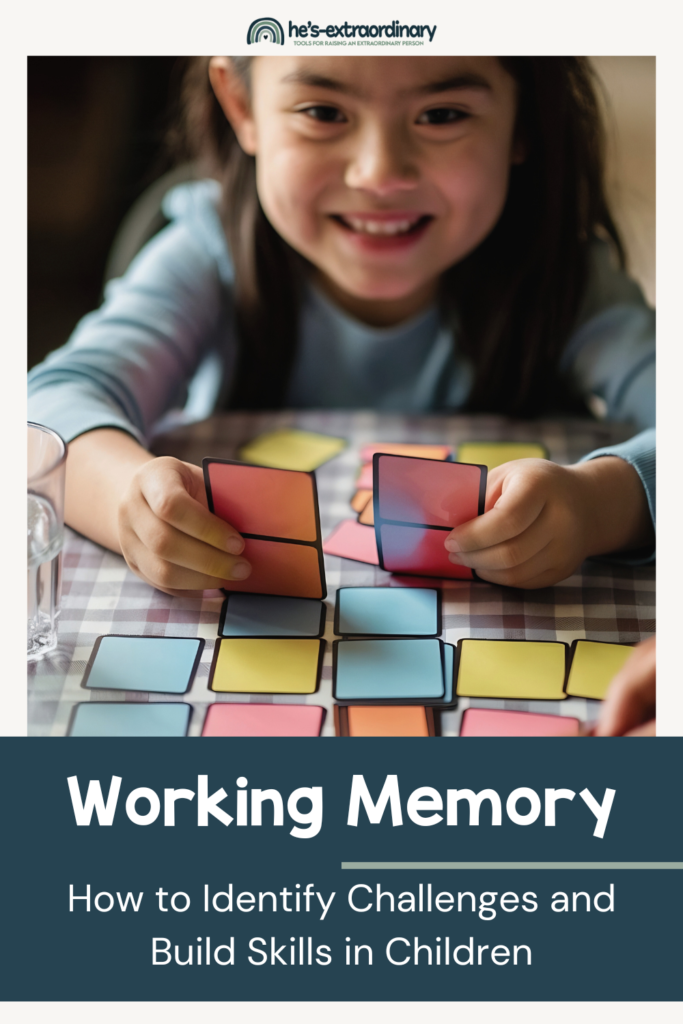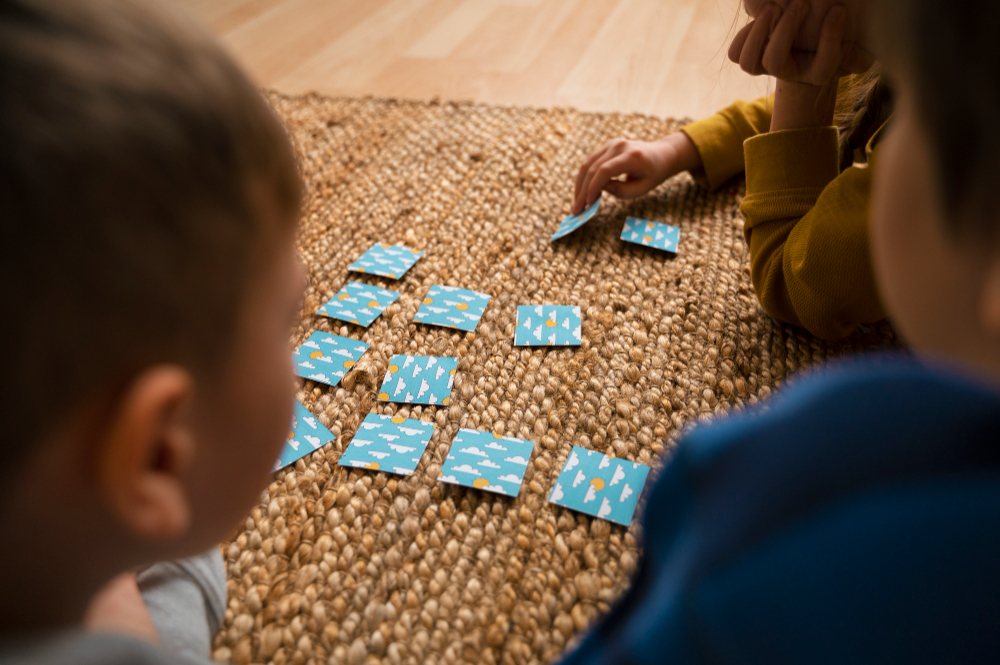What is Working Memory? How to Identify Challenges and Easy Ways to Build Skills in Kids
What’s inside this article: In this article, we’ll explore what working memory is and why it’s so important. We’ll discuss the common signs of poor working memory in children, provide helpful accommodations to support those who struggle, and fun working memory activities and games to help build this skill.
Disclaimer: This post contains affiliate links.
Working memory is an important executive functioning skill that helps us learn new information and perform everyday tasks. It plays a significant role in academic success, helping kids organize their thoughts, follow directions, and solve problems effectively.
Research shows that approximately 30-50% of children with ADHD have impaired working memory. This is significantly higher compared to children without ADHD. (Martinussen et al., 2005).
Fortunately, you can train your brain to improve this important skill. Research shows that practicing working memory skills, even for short times, such as 10 minutes per day, leads to an improvement.
MRI scans show that memory training increases the density of the cerebral cortex – the part of the brain responsible for executive functioning.
What is Working Memory?
Working memory is the ability to hold, process, and manipulate information over short periods, like while completing a task.
Basically, working memory is like a temporary sticky note for the brain.
- It operates only for a few seconds at a time, temporarily storing information that you need to use.
- It manipulates information that you need to use – such as sorting things into categories or canonical order or performing mental math.
- Working memory requires attention, although attention is separate from working memory. Attention allows information to be taken in for working memory to use.
Types of Working Memory
There are two main types of working memory: verbal working memory and visuospatial working memory.
Verbal Working Memory
Verbal working memory involves the ability to hold and manipulate information related to language, such as remembering a phone number long enough to dial it or following spoken instructions.
Visuospatial Working Memory
Visuospatial working memory is the ability to process and manage visual and spatial information, such as remembering the location of objects, navigating through a room, or visualizing how pieces fit together in a puzzle.
What Do We Use Working Memory For?
Working memory is an automatic function, so it’s not something we think about, but it is something we use constantly in day-to-day life.
We use working memory for:
- Following multi-step instructions
- Engaging in conversations and remembering what was said
- Paraphrasing or summarizing information
- Problem-solving and decision-making
- Performing mental math calculations
- Reading comprehension (remembering what was read and understanding context)
- Organizing daily tasks and activities
- Keeping track of information needed to complete a task
- Navigating new or complex environments
- Planning and prioritizing tasks
- Learning new skills and information
- Remembering names, dates, and other facts
- Self-monitoring and adjusting behavior based on feedback
Signs of Poor Working Memory
Poor working memory can lead to an array of difficulties and challenges.
It leads to difficulties in almost all academic areas, particularly reading, writing, and math, because it makes it difficult to keep up with classroom instructions and complete assignments correctly.
In social settings, poor working memory can result in difficulty following conversations, remembering social cues, or participating in group activities. This can lead to misunderstandings, social withdrawal, or being perceived as inattentive by peers.
These challenges will become more apparent as children get older and expectations increase.
If your child is struggling with working memory, here are some things you may notice:
- Makes mistakes when taking notes: Struggles to copy down information accurately from the board, often missing important details.
- Frequently forgets instructions: Needs to be reminded repeatedly of what they are supposed to do, even if instructions were given just moments earlier.
- Loses track of tasks: Starts a task but gets lost midway, unable to remember the next step or where they left off.
- Fails to self-correct: Doesn’t notice mistakes or errors in their work, even when corrections are being discussed or reviewed in class.
- Easily distracted: Has difficulty staying focused on tasks, especially those that require sustained attention, leading to incomplete work.
- Difficulty with multi-step tasks: Struggles to follow through on tasks with multiple steps, often skipping or forgetting steps entirely.
- Forgets what they were about to say: Loses their train of thought during conversations.
- Poor academic performance despite effort: Despite putting in time and effort, struggles to achieve expected academic results due to difficulty retaining and processing information.
- Problems with reading comprehension: Has trouble understanding and remembering what they’ve read, often losing their place on the page or struggling to grasp the meaning of the text.
- Struggles with mental math: Finds it hard to do calculations in their head, as they can’t hold numbers and operations in mind long enough to perform the math.
- Poor problem-solving skills: Finds it difficult to solve problems effectively, often getting stuck because they can’t hold all the necessary information in mind.
- Needs constant reminders: Requires frequent prompts to stay on task or to remember what they were doing, both at home and in school.
Accommodations for Children with Poor Working Memory
Accommodations are simple changes or supports made in the classroom or at home to help kids with specific needs access learning and meet expectations more effectively.
These adjustments don’t lower expectations or change what’s being taught; they just make it easier for kids to be successful.
Children with poor working memory can benefit significantly from accommodations, both at school and at home. These accommodations can help reduce cognitive load, improve focus, and enhance academic and social success.
Here are some effective strategies:
In the Classroom:
- Use Visual Aids: Provide visual schedules, charts, and diagrams to reinforce verbal instructions. Visual aids help children remember tasks and organize information more effectively.
- Break Tasks into Smaller Steps: Divide complex tasks and assignments into manageable, sequential steps. Provide only one or two instructions at a time, and ensure the child completes each step before moving on to the next.
- Provide Written Instructions: Offer printed or digital copies of instructions and class notes. This allows the child to refer back to the information as needed, reducing the reliance on memory.
- Use Checklists and Planners: Provide checklists for tasks and planners for organizing assignments to help kids keep track of what needs to be done and in what order.
- Allow Extra Time for Tasks: Provide additional time for completing assignments and tests. Children with working memory challenges may need more time to process information and complete their work accurately.
- Technology Aids: Use apps and tools that support working memory, such as digital organizers, reminder apps, and audiobooks.
- Provide Frequent Breaks: Schedule short breaks during longer tasks or lessons. Breaks help children recharge and maintain focus, preventing cognitive overload.
At Home:
- Create a Structured Environment: Maintain a consistent daily routine to minimize the amount of planning and organizing required from the child.
- Use Visual Reminders and Schedules: Post visual reminders around the home for tasks like chores or homework schedules.
- Break Household Tasks into Steps: Just like in school, break down household tasks into smaller, manageable steps. Provide clear, step-by-step instructions for chores and activities.
- Encourage the Use of Memory Aids: Provide and encourage the use of tools like sticky notes, whiteboards, and digital reminders to help your child remember important tasks.
- Minimize Distractions: Create a quiet, clutter-free space for homework and study time. Reducing distractions can help the child focus better and manage tasks more effectively.
Games and Activities to Improve Working Memory
Working memory training is a practical and engaging way to improve your child’s working memory.
Regularly participating in activities that challenge working memory can strengthen children’s ability to hold and manipulate information, improving learning, attention, and problem-solving skills.
Research shows that even short daily practice sessions can positively impact working memory capacity and overall cognitive functioning.
Jigsaw Puzzles
How It Helps: Jigsaw puzzles require children to use visuospatial working memory to remember shapes, colors, patterns, and how they fit together to form a larger picture.
Age-Appropriate Use:
- Younger Children: Start with puzzles that have larger pieces and simple images. Puzzles with fewer pieces are less overwhelming and more manageable.
- Older Children: Use puzzles with smaller pieces and more complex designs to increase the challenge and engage working memory further.
Memory Matching Games
How It Helps: Memory games involve flipping cards over to find matching pairs, requiring children to remember the location of various cards. This strengthens both visual memory and concentration.
Age-Appropriate Use:
- Younger Children: Use fewer cards with simple images or colors to make the game easier and suitable for their level.
- Older Children: Increase the number of cards and introduce more complex images to enhance the difficulty.
Simon (Electronic Memory Game)
How It Helps: Simon challenges children to remember and repeat sequences of colors and sounds. As the game progresses, the sequences become longer and more difficult, which helps train both visual and auditory working memory.
The Tray Game
How It Helps: This game involves showing your child a tray with various household items for a brief period, then covering the tray and asking them to recall as many items as possible. It trains visual memory and attention to detail.
Age-Appropriate Use:
- Younger Children: Use a few items (3-4) on the tray and give more time for memorization.
- Older Children: Increase the number of items and reduce the memorization time to boost the difficulty level.
Math Stacks
How It Helps: This card game requires children to solve mental math problems and use working memory to hold numbers and operations in mind while building stacks of cards with equal values.
There are different versions of this game for different grade levels and math units.
Sudoku
How It Helps: Sudoku puzzles require children to keep a series of numbers or symbols in their heads while mentally placing them in a grid. This relies heavily on working memory and logical reasoning.
Age-Appropriate Use:
- Younger Children: Use simplified versions of Sudoku with smaller grids (e.g., 4×4) and/or use colorful shapes or pictures instead of numbers.
- Older Children: If your child is ready, introduce the classic 9×9 Sudoku puzzles to provide a greater challenge.

Conclusion
Working memory is a vital skill influencing our ability to learn, follow directions, and perform daily tasks effectively.
By recognizing the signs of poor working memory and implementing supportive accommodations at home and school, you can help your children improve this skill.
Spending 10 minutes per day engaging in targeted games and activities is enough to strengthen their working memory, leading to improved focus, problem-solving, and overall cognitive development.

